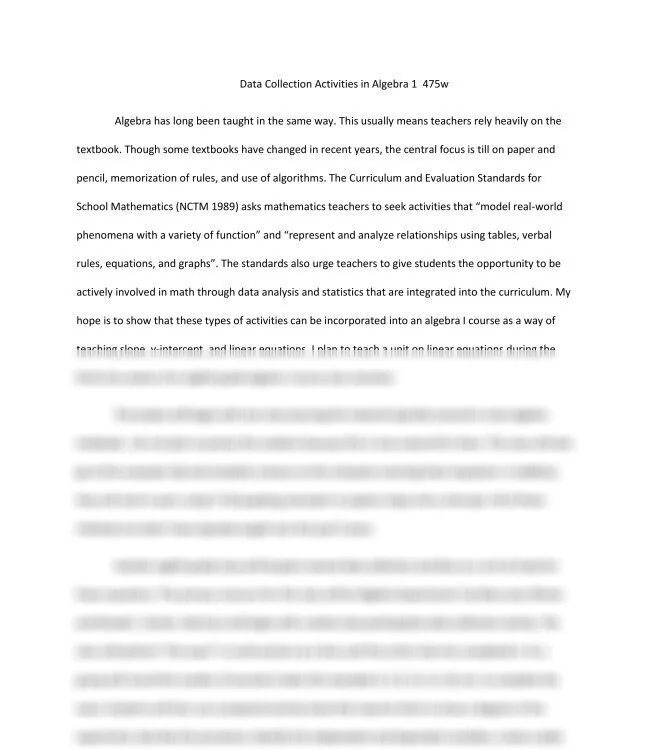Data Collection Activities in Algebra 1 475w Algebra has long been taught in the same way. This usually means teachers rely heavily on the textbook. Though some textbooks have changed in recent year
Data Collection Activities in Algebra 1 475w Algebra has long been taught in the same way. This usually means teachers rely heavily on the textbook. Though some textbooks have changed in recent year
(1), (1992) (1992). (1993) (1993). (1994) (1994). (1995) (1995). (3), (4), (8), (9), (CIA) (NCTM (for 1 11 13, 14 15, 1989) 20, 268-73. 3, 325-57. 361-37. 41-73. 475w 5 5, 650-56. 741-43. 75-109. 8, 800-meter 86, 88 9-14. A A., Activities After Algebra All Another As Assessment Behavior, Bell Bell, Canada. Carlson. City, Collection Computer-Intensive Computers Conference Curriculum Describes Dugdale Dugdale, E. Each Education Evaluation Experiments Exploring For Form From Group Harvey Harvey, He Heid, Held I In International It J. Jean Journal K. Learning M. Magidson Magidson, Mary Mathematical Mathematics Mathematics, Menghini Menghini, Mercer Mercer, My NCTM Peacock, Purpose Quebec References Regression Ronald S. School Science Seventh She Since Standards Students T1-82 Teacher, Teaching Teaching, Technology The They This Though Wallace Wallace, What Winter Working a able about abstracts action actively activities activities, activity activity. actual addition, address addressed. algebra algebra. algebra: algebraic algebraically algorithms. all also an analysis analyze and another any application. applications approach are article articles as asks assessment. at attitudes, authors based basic be bear because been begin best better book by calculator calculator. calculators. can capabilities central certain challenges, changed choose chosen class classroom.” classroom: collaboratively, collection comment communication compare complete completed computer concepts concepts. concerns conference. connect constructivist course covered covering create current curriculum curriculum. daily data data, day day's dependent describe description designed develop diagram directions, do do. does done draw during each eighth-grade encounter entire entirety. environment equations equations, equations. etc. example) experiment experiment, experiment. experiments explore felt few. find fit”, five focus focuses for format four from functions functions.” function” gathered generalizations/modes give given go goal graph graphing graphs. graphs”. grasped group hand, has have have. heavily help high hope hot how idea identify if importance important in include incorporated incorporating independent influence instruct integrated interact, interest interpret into investigation/argument. involved involving is issues issues, it it. its journal. junior keep keynote knowledge lab laboratory learned learning learning, lengthy lesson lessons like line linear linked list long make material math mathematical mathematics me meaningful, means memorization men's methods modifications most must my new next nine not number of offers on one only opportunity or other others, others. out. over pairs paper paper. participation past past. pencil, perform performance. perspective. phenomena philosophy plan plans. points potential power predictions. prepared presents pretest previous primary problems. problems.” procedure, project promising proposed provide purpose questions questions. question”. read real real-work real-world reasoning recent record records reflecting, reflects reform reform. reform: regression relate relationships relationships, rely representation representations representative require requires research resource reviews rewards richer risks, rules, run same say school scores. search secondary seconds sections seek semester semester. setting, settings several sheet show similar six skill.” slope slope, slope-intercept small some speaker specific spoke standards standards. statistics still students students' study study. subsequent suggest survey tData table tables, takes taught teach teachers teaching teaching, teaching. technology technology-intensive technology-rich test textbook. textbooks textbooks. than that that, the them them. then these they third this three through till time to topic topics trends tried two types typically understanding unit until upper urge use used uses using usually variables, variables/functional variety verbal verbally, very was wave. wave” way way. weeks well what whole will with wo women's work world would written y-intercept y-intercept, y-intercept. years, years. your “Algebra “a “addresses “bring “claims “compares “current “line “model “represent “the
Data Collection Activities in Algebra 1 475w
Algebra has long been taught in the same way. This usually means teachers rely heavily on the textbook. Though some textbooks have changed in recent years, the central focus is till on paper and pencil, memorization of rules, and use of algorithms. The Curriculum and Evaluation Standards for School Mathematics (NCTM 1989) asks mathematics teachers to seek activities that “model real-world phenomena with a variety of function” and “represent and analyze relationships using tables, verbal rules, equations, and graphs”. The standards also urge teachers to
